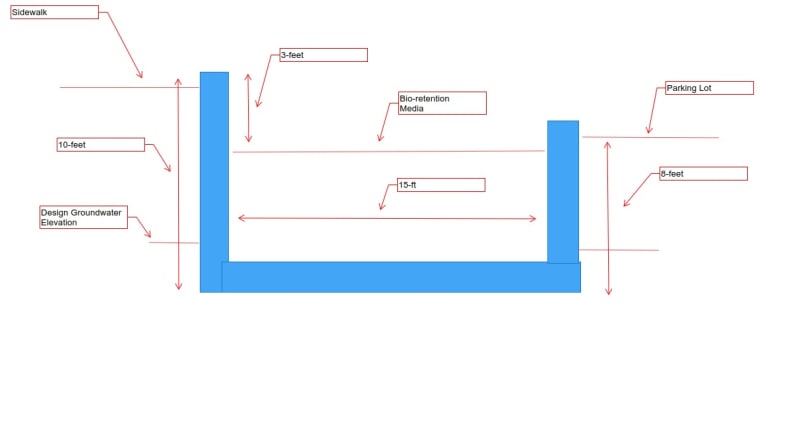ahardy89
Structural
- May 26, 2020
- 15
I have a situation where we are designing a cast-in-place reinforced concrete bioretention structure. The structure is a U-Shape structure with one side higher than the other (so it is acting as a retaining structure of sort). The water table is relatively high (the reasoning for the included base slab for the bioretention). The structure is in a parking lot. The high side has a 12-ft sidewalk before reaching the pavement but I have included a 250psf live load per IBC (incase trucks were to drive up on the sidewalk). The low side abuts against the parking lot asphalt. Sketch Provided Below.
The tricky components:
1. There is a differential in height so one side has a net driving force.
2. The slab cannot extend past the exterior face of the wall on both sides to take advantage of additional dead load.
3. The water table is above the base slab (so sliding resistance through friction is reduced due to reduce net weight).
Originally I checked the stability of the wall using at-rest pressures applied on both sides. The live load was only applied on high side (worst case) and the interior of the bioretention was assumed to be drained. The uplift pressures reduce the effective weight which is causing the sliding factor to not meet the minimum 1.5 even with the weight of soil inside.
I feel like visually this should work because the differential in height is only 2-3 feet. The numbers are showing it is not (mainly because of the high groundwater and high live load).
My question to the group - Is it more reasonable to use active and passive pressures (conservatively reducing passive pressures and ignoring 2 feet of the soil) instead of at-rest pressures? I do not think the movement needed to activate active and passive is detrimental to the structure.

The tricky components:
1. There is a differential in height so one side has a net driving force.
2. The slab cannot extend past the exterior face of the wall on both sides to take advantage of additional dead load.
3. The water table is above the base slab (so sliding resistance through friction is reduced due to reduce net weight).
Originally I checked the stability of the wall using at-rest pressures applied on both sides. The live load was only applied on high side (worst case) and the interior of the bioretention was assumed to be drained. The uplift pressures reduce the effective weight which is causing the sliding factor to not meet the minimum 1.5 even with the weight of soil inside.
I feel like visually this should work because the differential in height is only 2-3 feet. The numbers are showing it is not (mainly because of the high groundwater and high live load).
My question to the group - Is it more reasonable to use active and passive pressures (conservatively reducing passive pressures and ignoring 2 feet of the soil) instead of at-rest pressures? I do not think the movement needed to activate active and passive is detrimental to the structure.

